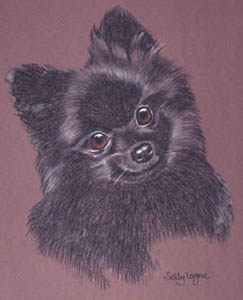Recent Pet Portraits
Search Archive
Dog Portraits
Cat Portraits
Horse Portraits
Rabbit Portraits
Sheep and Pigs
Farm Animals
Bird Portraits
People Portraits
People with Pets
Portraits of Children
Special Commissions
INFORMATION
Information
Portrait Order Form
Customer Comments
Contact
Prices
About the Artist
Gift Vouchers
Prints and Gifts
Taking Photos of Pets
Pomeranian Portraits in Pastel by UK animal portrait artist
Guaranteed good likeness - preview your portrait online
prior to payment and dispatch!

Cherie
Pomeranian Portrait by Sally Logue
Search the Dog Portrait Galleries for more pomeranians
Search for Breed Information - Pomeranians
This compact little dog is a wonderful companion. An extrovert which is affectionate, obedient and full of character. For their size Pomeranians are excellent house dogs with a deep bark.
Description & History
The Pomeranian is the smallest member of the Spitz group and came from Pomerania in the north of Germany. The breed was well established on the continent before arriving in Britain in the 1880's.
Although now classified as a toy, the breed when first introduced to Britain was a large white herding dog, weighing up to 13 kg. Selective breeding and naturally smaller whelps gradually produced a dog one tenth of the size of the original north German sheepdog. The reduction in size did not alter the physical characteristics of the breed. It has the typical ruff, small erect ears, straight hind legs, and the attractive tail - carried over its back - of all Spitz breeds.
Pomeranians became popular in the late nineteenth century mainly due to royal interest. In 1883 Queen Victoria, when visiting Florence, saw these dogs and formed an attachment to them. Later she established a kennels in England for the breed and exhibited a number of dogs, being particularly successful at Crufts Dog Show.
In 1891 six dogs were shown from the royal kennels at Crufts Dog Show and all won prizes. The Pomeranian has great intelligence and a natural gift for learning, which made it a popular circus performer.
Like all dogs in the Spitz group, it is an independent breed and shows this characteristic from an early age.